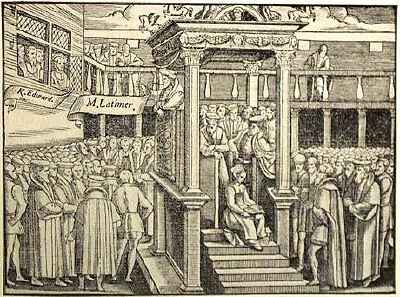Edward VI and Mary I: extremes
After the death of Henry VIII, England underwent violent change, first towards Protestantism, under Edward, then back to Catholicism under Mary.
During Edward's short-lived minority (1547-53) the Church of England was reshaped by his strongly Protestant advisors. Reforms were relatively moderate at first*, but eventually radical Protestants gained full sway and an attempt was made to rid the Church of all vestiges* of "popery."
When Mary Tudor, a devout Catholic, came to the throne in 1553, she sought to restore Roman Catholicism and papal authority in England. Aligning herself with her cousin, the Holy Roman Emperor Charles V, she became engaged to his son, Philip of Spain, and later married him. Through parliament, she cancelled Henry's divorce from Catherine of Aragon, repealed all religious legislation enacted under Edward VI, and returned England fully to the Pope's authority.
Why "Bloody" Mary?
Mary was fanatically determined to suppress Protestantism. Old laws against heretics were revived, and under Reginald Pole, the new Archbishop of Canterbury, almost 300 men and women, including Thomas Cranmer, were burned at the stake for heresy between February 1555 and November 1558--almost as many in thirty-four months as were executed for religious reasons in forty-five years under Elizabeth I.
Many Protestant clergymen--the "Marian exiles"-- fled to Germany or Switzerland when Mary came to the throne. There they picked up the doctrines and practises of Lutherans, Calvinists and Zwinglians. They returned after Mary's death and were instrumental in modifying Anglican doctrine along Protestant lines.
Footnotes
-
The progress of Protestantism
Cranmer's first Book of Common Prayer still implied the Real Presence of Christ in the sacrament of the Lord's Supper. With the death of Martin Luther (1546) and the Emperor's successes against the German princes there was a decline in the influence of Lutheranism; English reformers turned to the more radical teachings of Calvin and Zwingli for guidance, and invited leading Protestants from the Continent to help supervise changes in England.
-
Removing"popery"
For example, in the second Prayer Book (1552) the notorious Black Rubric stated clearly the Calvinist view that Christ's flesh, blood, or spirit were in no way present in the sacrament.
On a local level, there was a violent surge of iconoclasm--stained glass windows were shattered, and statues and painted images were destroyed or defaced. Heretical books in the universities were burned, and school enrollment declined.
The Black Rubric
For as concerning the sacramental bread and wine, they remain still in their very natural substances, and therefore may not be adored, for that were idolatry to be abhorred of all faithful Christians.
